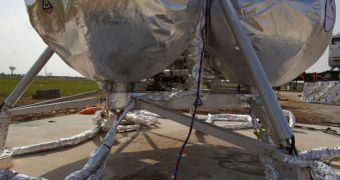The American space agency is pushing ahead with tests of its new, advanced lunar lander, in spite of an incident that accompanied a live engine firing a couple of days ago. On Wednesday, June 1, a tethered flight test sparked a grass fire at the test location.
The incident did not have any significant outcome, as engineers and emergency responders were able to stop the mayhem from spreading. The fire was apparently ignited by hot concrete that was ejected from underneath the futuristic spacecraft as it underwent its testing.
Experts at the NASA Johnson Space Center (JSC), in Houston, are in charge of constructing the Morpheus lunar lander. They say that the fire kicked off at around 2:30 pm local time (1530 GMT).
They add that the main goal of the spacecraft is to act like a testbed for a wide variety of state-of-the-art technologies. All of these innovations were created especially for spaceflight, but thus far they were never tested on their own, let alone together.
In the end, these technologies will make it easier for NASA to return its astronauts to the Moon, near-Earth objects (NEO), and Mars. Even further space exploration may become possible as well.
NASA spokeswoman Brandi Dean says that the test teams did their best for reducing fire hazards. “It's been really dry. They had done controlled burns around the area to try and prevent grass fires,” she says.
Using reinforcements called in from the Houston fire department, and also other local firefighters, the JSC emergency responders were able to put out the fire in just a few hours, before the devastation had a chance to cause any significant damage.
Despite the outcome, experts say that the test in itself was a success, which is why they plan to move ahead as planned. “Actually the test went really well and Morpheus itself was fine,” Dean explains.
“Nobody was hurt. There wasn't any damage at all to the vehicle and the launch pad,” the spokeswoman tells Space. The tethered flight lasted for as much as 30 seconds, before the JSC engineers discontinued the thrusters.
Due to the remarkable progress the spacecraft and its team are making, NASA is considering beginning untethered flight as early as this summer. Once that milestone is reached, the platform will be deemed space-worthy as far as propulsion and avionics controls go.

 14 DAY TRIAL //
14 DAY TRIAL //